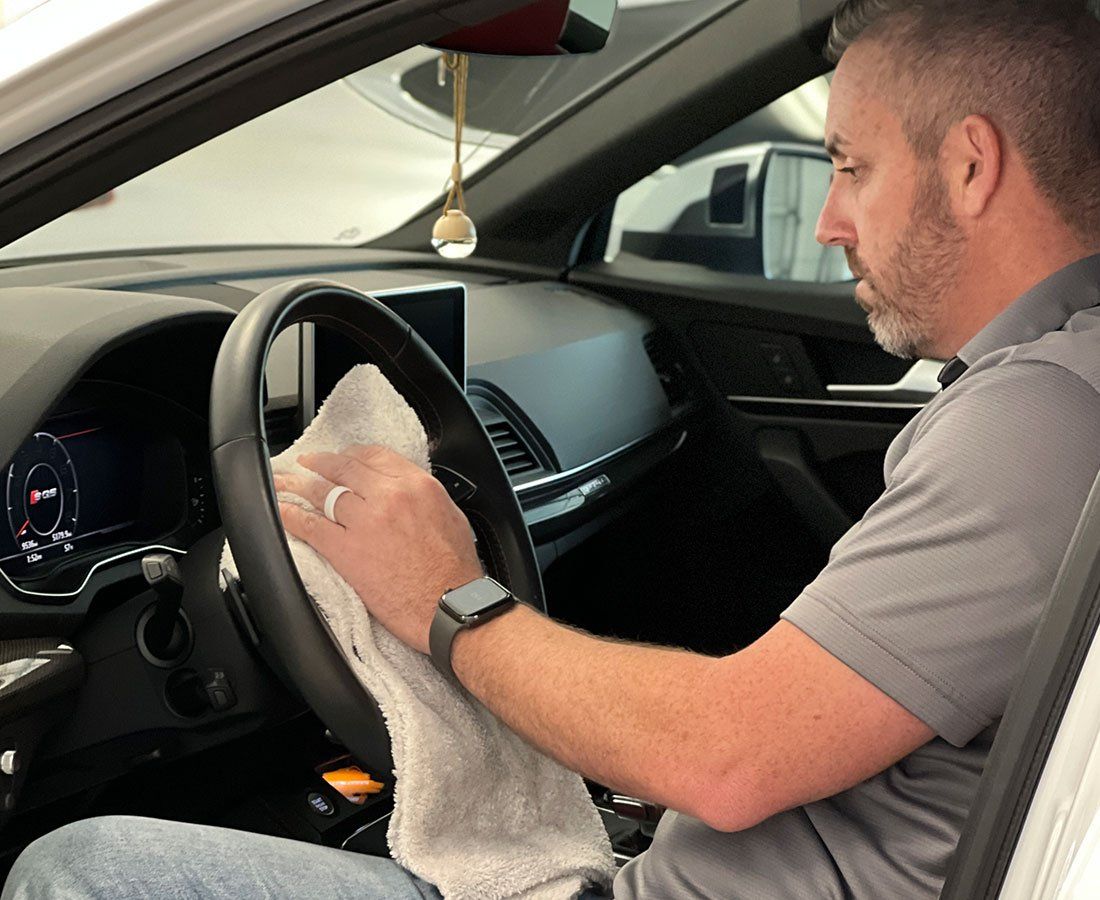Best Way to Disinfect Car Interiors Without Damaging Leather or Plastics
Keeping a car’s interior clean, especially with leather and plastic surfaces, requires a careful approach. For instance, knowing how to disinfect car seats without risking wear involves choosing the right materials and cleaning agents, especially on sensitive surfaces like leather. For those seeking convenience and professional care, mobile interior detailing services offer a thorough clean that preserves the integrity of your interior surfaces. Here’s a guide to effectively disinfecting your car interior without risking damage, ensuring it stays hygienic and looks fresh over time.
Preparing for a Safe and Effective Clean
The first step to a successful interior cleaning session is to gather all the right supplies. Using soft, non-abrasive materials is essential, as rough cloths or hard brushes can scratch and damage delicate surfaces. Microfiber cloths are ideal because they’re gentle yet effective at picking up dirt without leaving scratches. Soft-bristle brushes work well for reaching dust and debris in small crevices.
When selecting a disinfectant, aim for alcohol-free options or those specifically marked safe for leather and plastic. Strong disinfectants like those containing alcohol can dry out leather and cause plastic to fade over time. Instead, look for mild, pH-balanced cleaners that are gentle but still effective at removing bacteria and grime.
Before you start, test your chosen products on a hidden spot, such as an area under the seat. Even products labeled as “safe” can react differently with the wide range of leather and plastic finishes used in car interiors. Testing in a discreet spot ensures you won’t be left with any unpleasant surprises. Ventilation is also essential, as even mild cleaners can release fumes. Open windows or doors while cleaning to allow airflow, making the experience safer and more comfortable.
Choosing Suitable Disinfectants for Leather and Plastic
Leather and plastic have different needs, and choosing the right disinfectant for each is essential for preserving their quality. Car interior sanitizing requires the right products to maintain surfaces like leather and plastic without damage. Knowing how to disinfect car seats with the proper tools and solutions will help keep your car's interior both clean and well preserved. Here’s a closer look at options that work best for each material.

Alcohol-Free Disinfectants
While alcohol is a powerful disinfectant, it’s often too harsh for leather and plastic. Alcohol can strip away natural oils from leather, leading to dryness, brittleness, and cracking over time. On plastic, alcohol can make surfaces brittle and more prone to breaking, especially with repeated exposure. Alcohol-free sprays and pH-balanced disinfectants are a better choice, providing effective cleaning without causing harm. Check product labels to ensure they’re safe for these materials.
Hydrogen Peroxide as a Cautionary Option
Hydrogen peroxide is often recommended as an effective disinfectant, but it’s not always safe for every part of the car interior. While it can work well on some plastic surfaces, it’s best avoided on leather, as it can interfere with the natural oils that keep leather soft and flexible. Use hydrogen peroxide sparingly if needed and avoid applying it to leather altogether to prevent potential issues with drying or discoloration.
Leather-Specific Cleaners
Leather has unique properties and requires different care than plastic or vinyl. To disinfect leather effectively without harming it, choose a leather-specific cleaner that can handle dirt and bacteria while conditioning the material. These cleaners help maintain leather’s natural texture, preventing it from drying out. Look for products designed to lift dirt gently and preserve the suppleness of leather.
Step-by-Step Process for a Safe Clean
Each material in a car’s interior requires a slightly different approach to cleaning. Here’s a breakdown of a step-by-step cleaning process to effectively tackle leather, plastic, and other interior materials.
Step 1: Remove Dirt and Debris
Vacuuming is the first step in cleaning your car’s interior, as it helps eliminate loose dust, dirt, and particles. Start by vacuuming the seats, floor mats, and surfaces. Use attachments to get into tight spaces and hard-to-reach areas. Vacuuming first prevents dirt particles from scratching surfaces when you start wiping them down.
Step 2: Clean Hard Surfaces
Plastic and vinyl, commonly found on dashboards, consoles, and door panels, are best cleaned with a disinfectant sprayed onto a microfiber cloth. Avoid spraying directly onto these surfaces, as this can cause liquid to pool in seams or crevices, which may affect electronics or controls. Gently wipe down each surface, focusing on high-touch areas like the dashboard, steering wheel, door handles, and controls. Microfiber cloths are especially effective on plastic because they trap dust and dirt without leaving lint behind.
Step 3: Disinfect and Clean Leather Seats
Leather seats require a gentler approach. Spray a small amount of leather cleaner onto a microfiber cloth rather than applying it directly to the seats. Clean the leather in sections, using small circular motions to remove dirt and buildup. Avoid oversaturating the leather, as excess moisture can lead to staining and may affect the leather’s texture. Take extra care with areas that see frequent use, like headrests and armrests, as they’re more likely to have accumulated bacteria.
Step 4: Condition the Leather After Cleaning
Leather conditioning is essential after disinfecting to maintain the material’s natural oils and softness. Apply a small amount of conditioner to a clean microfiber cloth and work it into the leather in small circular motions. This will help keep leather supple and prevent cracking. Leather typically needs conditioning every few months, but if your car is often in direct sunlight or a dry climate, more frequent conditioning may be beneficial.
Avoiding Common Mistakes During Interior Cleaning
Each material in a car’s interior requires specific care, and avoiding common mistakes can make a big difference in the outcome. Here’s a step-by-step guide on how to disinfect car seats and tackle mobile interior detailing effectively.
Avoid Overusing Cleaner
It’s easy to think more product will give a better clean, but overusing disinfectant can lead to residue buildup and streaks. Stick to a small amount of cleaner applied directly onto a cloth, which gives you more control and reduces waste.
Don’t Skip Leather Conditioning
Leather that’s cleaned regularly can dry out over time. Skipping conditioning leaves leather vulnerable to cracking and looking worn. Conditioning not only keeps leather soft and flexible but also helps it retain its natural color and texture. Aim to condition every few months to maintain the appearance and longevity of leather surfaces.
Pay Attention to Small Crevices
Controls, buttons, and other small crevices can collect bacteria and dirt, making them important to clean even if they’re less visible. Using a small brush or cotton swab is effective for these areas, allowing you to reach dust and grime without risking scratches.
Keeping the Interior Fresh and Clean Over Time
Regular mobile interior detailing makes maintenance easier and keeps your car’s interior looking its best.
Routine Weekly Wipe-Downs
A quick wipe-down of high-touch areas like the steering wheel, door handles, and controls can reduce the buildup of germs between more thorough cleaning sessions. Using a lightly damp microfiber cloth is enough to maintain cleanliness and prevent heavy buildup.
Monthly Deep Cleaning
A more thorough monthly clean, including disinfecting and conditioning leather, keeps dirt, dust, and bacteria from accumulating. Monthly deep cleans help maintain a high level of hygiene and keep the interior materials from becoming too soiled, making routine upkeep easier.
Protect Against UV and Heat Damage
Exposure to UV rays and heat can cause fading and warping in both leather and plastic surfaces, especially if the car is frequently parked outdoors. Sunshades and UV-protective sprays can prevent damage to your car’s interior, maintaining the color and condition of these materials over time. For a more detailed approach, contact Obsessed Detail and Restoration for mobile interior detailing services in South Jordan. Their expertise ensures safe, thorough cleaning tailored for leather and plastic interiors, keeping your car’s interior fresh and well-maintained.
Frequently Asked Questions (FAQ)
Is vinegar safe for leather seats?
No, vinegar is acidic and can dry out or damage leather over time. It’s best to use cleaners made specifically for leather to avoid harming the material.
How should I clean touchscreens in my car?
Touchscreens are sensitive and can scratch easily, so use a microfiber cloth dampened with water or a screen-safe cleaner to avoid streaks and scratches.
How can I keep my car smelling fresh without damaging surfaces?
Regular ventilation helps, and using odor-neutralizing sprays designed for car interiors can keep the cabin smelling pleasant without affecting the materials.


